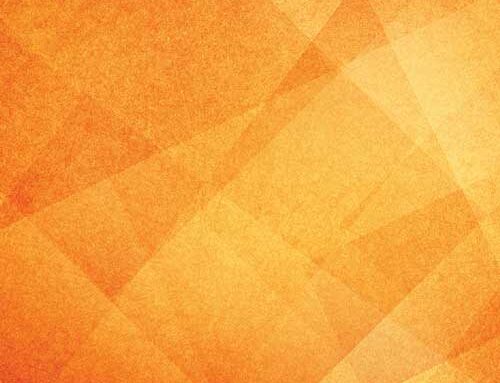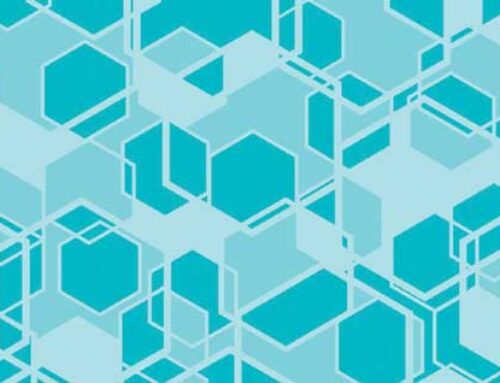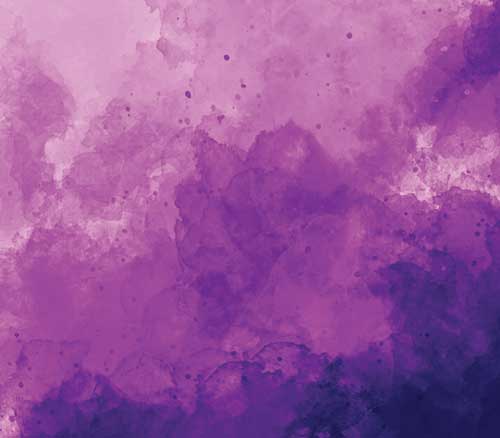
by Uzma Ilyas, PhD scholar; Farwa Aslam, MS; Muqadas Fatima, MS; Zarmin Tariq, MS; and Prof Dr. Usman Hotiana, MBBS, FCPS (Psychology)
Ms. Ilyas is Principal Lecturer, Psychology Department, University of Central Punjab in Lahore, Pakistan. Ms. Aslam is with Iqra University in Islamabad, Pakistan. Ms. Fatima is with University of Central Punjab in Lahore, Pakistan. Ms. Tariq is with University of Management and Technology in Lahore, Pakistan. Prof. Dr. Hotiana is Head of Behavioral Sciences & Psychiatry Department, Rashid Latif Medical & Dental College in Lahore, Pakistan.
Funding: No funding was provided for this article.
Disclosures: The authors have no conflicts of interest relevant to the contents of this article.
Innov Clin Neurosci. 2024;21(1–3):31–35.
Abstract
Objective: This study examined fear of COVID-19, nosophobia, health anxiety, and health-protective behaviors among healthcare professionals during the COVID-19 pandemic.
A cross-sectional, correlational research design was used in this study. The data of healthcare professionals (N=300) from three disciplines of medicine (Bachelor of Medicine and Bachelor of Surgery [MBBS], Bachelor of Dental Surgery [BDS], Doctor of Physiotherapy [DPT]) were collected using a purposive sampling technique. The Fear of COVID-19 Scale (FCV-19S), Medical Student Disease Perception and Distress Scale (MSD), Short Health Anxiety Inventory (SHAI), and Health Protective Behavior Scale (HBPS) were used as assessment measures. Statistical Package of Social Sciences (SPSS) version 22 was used to analyze the data obtained.
Results: Of the 300 participants, 132 (44%) were male and 168 (56%) were female. A total of 199 participants (63.3%) had a MBBS degree, 59 (19.7%) had a BDS degree, and 41 (14%) had a DPT degree. The findings revealed a significant positive correlation between nosophobia, health anxiety, and fear of COVID-19, whereas health-protective behavior showed a negative association with health anxiety. Sex, health anxiety, and nosophobia were significant predictors of health-protective behaviors among medical professionals.
Conclusion: The fear related to COVID-19 is associated with nosophobia and health anxiety among medical professionals, which has a substantial impact on health, work performance, and vulnerability to developing psychological distress if left unmonitored.
Keywords: Anxiety, nosophobia, health-protective behaviors, medical professionals
There have been over 770 million confirmed cases of COVID-19 and over 6.9 million deaths attributed to the disease worldwide as of December 2023.1 In particular, underdeveloped countries, such as Pakistan, were adversely affected by the COVID-19 pandemic due to already frail healthcare systems.2 COVID-19 has left health professionals at a psychological disadvantage, compared to other professionals or the general public, as they continue to provide healthcare despite potential threats to their own health.3 Among healthcare professionals, fear of COVID-19 has resulted in panic anxiety (38%) and workplace avoidance (30%).4 Healthcare professionals are cognizant of the severity of the outbreak, and the pandemic has had a detrimental effect on their thinking and decision-making abilities.5
The literature shows that healthcare workers, being in close connection with diseases, often experience intense fears related to contracting a disease, as well as health-related anxiety.6,7 A persistent and uncontrollable fear of contracting or having a dangerous disease has been defined as nosophobia or disease phobia in the literature,8,9 and this is prevalent among the healthcare community.10 Individuals with nosophobia often remain preoccupied with their bodily sensations, which are often misinterpreted as symptoms of a serious illness. In addition, they might exaggerate even minor symptoms while fearing a grave illness.11
Health anxiety is another phenomenon that is closely linked to nosophobia.12 Individuals with health anxiety experience an irrational concern about getting sick or having any illness, and they might fear or negatively interpret ordinary or unusual bodily sensations as illness.13 Health anxiety describes how individuals feel and behave in response to their health, which is normal and even adaptive. However, excessive health anxiety can be deleterious and result in dysfunctional beliefs and health-related attitudes.14 Behaviors associated with excessive health anxiety include repeated medical consultation, reassurance and information seeking, and resorting to protective measures even in the absence of potential symptoms.12 Although nosophobia and health anxiety are interrelated, they differ based on their precise focus, as nosophobia is related to fearing a specific life-threatening illness.8,9 Like nosophobia, health anxiety is also a common occurrence among health professionals. According to a recent estimate, about 30 percent of medical employees have health anxiety that significantly impacts their lives.7
Fear of COVID-19 affected healthcare professionals and the healthcare community during the pandemic,3,15 and prolonged lockdown added to this fear.16 According to one study, the countries with the highest rate of physician mortalities as of April 2020 were Italy (n=121), Iran (n=43), the Philippines (n=21), Indonesia (n=17), and China (n=16).17 In Pakistan, more than 202 doctors and 30 paramedics died due to COVID-19 as of May 2021.18 The death toll could potentially lead to intensified fears and anxieties related to COVID-19 experienced by the medical community. Research carried out during the COVID-19 pandemic has found recurrent health anxiety and nosophobia, derived from fear surrounding COVID-19, among the medical community across various countries,7,10,19 including Pakistan.20
Fear of COVID-19, in addition to already existing health concerns, could exacerbate health anxiety, resulting in an extreme affective and behavioral response.21,22 For instance, an individual experiencing severe health-related anxiety as a result of nosophobia and fear of COVID-19 might perform compulsive health-protective actions. These behaviors can be ritualistic in nature, such as in cases of extreme health anxiety or illness anxiety disorder.12,22 Research has also demonstrated that during the COVID-19 pandemic, the general public23 and healthcare workers, including doctors,23,24 exhibited reassurance-seeking behaviors for their bodily symptoms and uncertainties due to health anxiety. Research from a previous pandemic also demonstrated similar responses among health professionals, suggesting that an overestimation of the threat results in a specific interpretation of bodily sensations that increases anxiety.25 Extreme bodily concerns can cause healthcare professionals to engage in illness or safety behaviors that also maintain the cycle of anxiety and fear.26 Adherence to protective actions (e.g., checking on bodily changes, hygienic measures, information gathering) appears to derive from affective risk perception related to the pandemic.27 Engagement in reassurance-seeking and health-protective behaviors is intended to defend, promote, or sustain health, regardless of perceived or real health condition,24,28 but excessive engagement is distressing and dysfunctional.12
Existing literature has reported challenges faced by medical professionals, including fear of COVID-19, health anxiety, and engagement in health-protective behaviors. However, studies placed more emphasis on health anxiety, compared to nosophobia, which might have been influenced by pandemic circumstances. In particular, research in Pakistan has focused on systemic challenges and overall distress experienced by the healthcare community. It is important to address the emotional and behavioral aspects of the pandemic in a country with economic instability and yielding healthcare system; as such, the present study aimed to fill this gap through collectively addressing fear of COVID-19 and health anxiety experienced by healthcare professionals, as well as their behavioral responses to these experiences in term of their engagement in health-protective behaviors. This study also sought to highlight the challenges of emotional and cognitive perception related to contracting a disease that could be experienced by healthcare professionals serving under circumstances that require their adjustment skills to ensure effective management of any unforeseen events.
Methods
This study was approved by the ethical review board of the University of Central Punjab (Graduate Program Committee). Due to the potential threat of COVID-19, data were collected through both Google Forms and in person where applicable.
Study population. Following a correlational study design, data was collected from a total of 300 medical personnel within the age range of 24 to 28 years. The medical personnel who participated in the study were recruited from various government, semi-government, and private hospitals in Pakistan. The data were collected from May to July 2021.
Inclusion criteria. Healthcare professionals with a Bachelor of Medicine and Bachelor of Surgery (MBBS), Bachelor of Dental Surgery (BDS), or Doctor of Physiotherapy (DPT) degree; who served during the COVID-19 pandemic; and who had daily interaction with patients in hospitals were eligible for inclusion. Medical personnel in their house jobs (in Pakistan, house job refers to the time period in fifth year during which MBBS students work and practice in different departments) were included.
Exclusion criteria. Healthcare professionals diagnosed with a physical and/or psychological health condition were excluded. Healthcare professionals who graduated and were currently employed full time at hospitals were not included. Healthcare professionals with family members or friends who died due to COVID-19 were excluded.
Procedure. After obtaining written informed consent, participants completed a demographic questionnaire along with standardized assessment scales. The Fear of COVID-19 Scale (FCV-19S)29 was used to assess fear related to COVID-19 and includes seven items rated on a five-point Likert scale, ranging from strongly disagree (1) to strongly agree (5). The scale indicated good reliability, with an alpha value of 0.87. The scale has a minimum score of seven and maximum score of 35. The Medical Student Disease and Perception Scale (MSD)30 was used to investigate cognition and distress among the respondents. The scale includes 10 items rated on a five-point Likert scale, ranging from definitely false (1) to definitely true (5). The first five items of the MDS assess cognitive perception, while the last five items assess emotional perception. The scale indicated good psychometric standing, with an alpha value of 0.87. In addition to these measures, the Short Health Anxiety Inventory (SHAI)31 was used to measure illness or health-related anxiety and fear of negative consequences of an illness. The scale consisted of 18 items rated on four-point Likert scale (0 [no symptoms]–3 [very severe symptoms]). The scale showed good reliability, with an alpha value of 0.87. The Health-Protective Behavior Scale (HPBS)32 was used to assess health-protective behaviors among participants. The scale consists of 32 items rated on a five-point Likert scale. The HPBS measures protective behaviors in five dimensions: interpersonal support, general behavior, self-knowledge, nutrition behavior, and healthcare. The scale showed good reliability, with an alpha value of 0.87
After data collection, further statistical analysis was conducted using Statistical Package of Social Sciences (SPSS) version 22. The descriptive statistics calculated for evaluating data included frequencies, percentages, means, and standard deviations (SDs), which computed the demographics of medical professionals during the COVID-19 pandemic. Inferential statistics, including correlational and regression analyses, were used to assess the relationship between variables studied (fear of COVID-19, nosophobia, health anxiety, and health-protective behaviors) and examine nosophobia (perception and distress) as a predictor of health anxiety (illness attitude and negative consequences).
Results
Of the 300 medical professionals included in this study, 132 (44%) were male and 168 (56%) were female. Mean age was 25.45 (SD: 1.33) years. The data also revealed that 130 (43%) were eldest among their siblings, while 100 (34%) and 70 (23%) were middle and youngest, respectively. Among the study participants, 262 (87%) were single, 31 (11%) were married, four (1%) were divorced, and three (1%) were separated. About 192 participants (64%) were living in a nuclear family system, while 108 (36%) were living in a joint family system. A total of 199 participants (60%) had a MBBS, 59 (20%) had a BDS, and 42 (14%) had a DPT (Table 1).
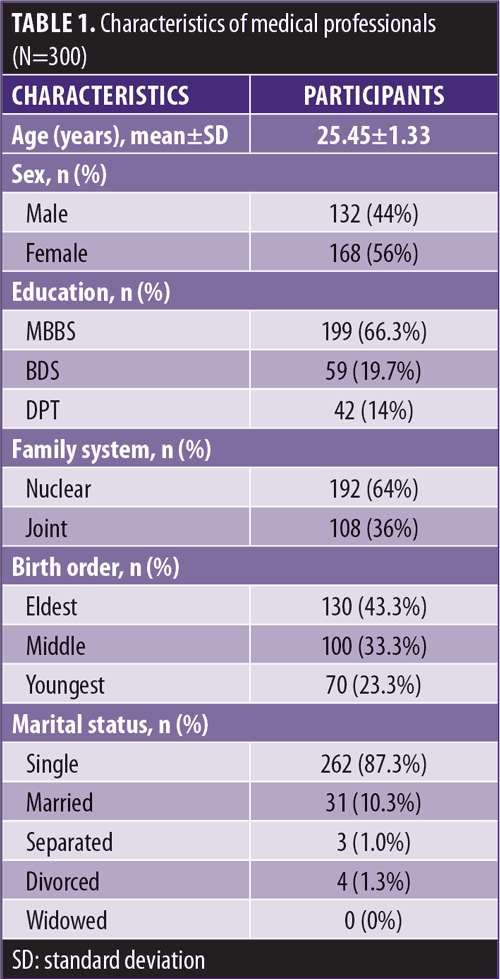
Fear of COVID-19 showed a significant positive association with both dimensions of nosophobia (perception and distress) and health anxiety (illness attitude and negative consequences) and all the health-protective behaviors (i.e., self-knowledge, nutrition behavior, general behavior, healthcare, and interpersonal behavior). Health anxiety also showed a similar significant positive association with nosophobia, but a negative, though significant, association with health-protective behaviors (Table 2). Furthermore, experiences related to health anxiety and nosophobia, as well as sex, were significant predictors of health-protective behaviors (Table 3) and contributed to 17, 12, and six percent of variance in the model, respectively.
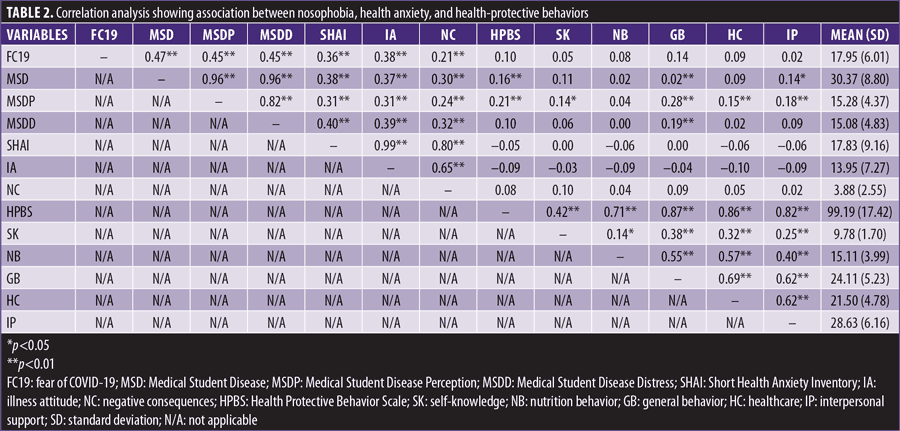
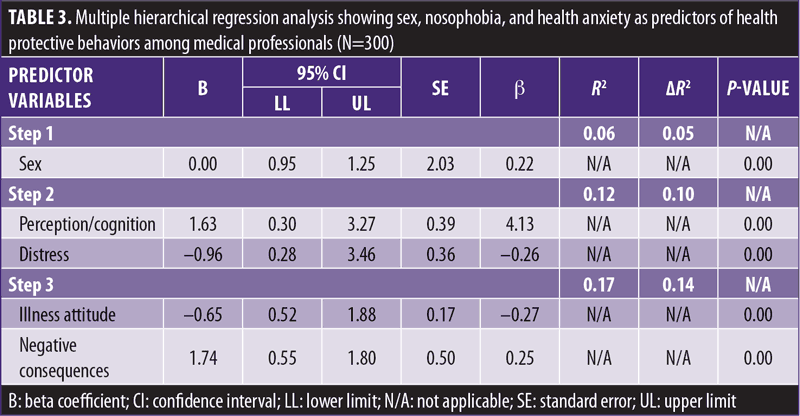
Discussion
The present study aimed to highlight the impact of the COVID-19 pandemic on the mental health of healthcare professionals in Pakistan, where the healthcare system is itself challenging. The study found that fear of COVID-19 had a positive link with nosophobia, health anxiety, and health-protective actions. The findings also demonstrated that health anxiety was inversely associated with health-protective behaviors. Health anxiety and nosophobia also led to the practice of health-protective behaviors among healthcare professionals.
The findings of the present study are also corroborated by the literature, which suggests a significant association between health anxiety and nosophobia among healthcare professionals. The studies suggest that the high prevalence of nosophobia and health anxiety in the medical community, compared to the general public, might be due to frequent interaction with patients and diseases.23 However, there can be other reasons for this difference, such as individual characteristics. Studies have shown that personal characteristics, such as neuroticism,33 psychological flexibility,34 self-efficacy, belief in conspiracies, and altruistic worries28 might lead to increased health concerns and maladaptive anxiety. Healthcare professionals experiencing cognitive perception of contracting disease were found to be operating with uncertainty and stress.35 Lack of personal protective equipment (PPE) in smaller towns added risk to doctors as well.36
Evidence has also demonstrated that the environment in which healthcare professionals work is a contributor to anxiety/health anxiety. It was shown that working under challenging circumstances, such as during the COVID-19 pandemic, was linked with heightened fear and anxiety.3,24 This response potentially occurred because the fear that developed in connection with COVID-19 resulted in emotional distress and posed a challenge to the psychological adjustment skills of healthcare professionals, both as professionals and as individuals.22 This evidence also supports the findings of the present study, as fear of COVID-19 showed a significant positive association with health anxiety and nosophobia among medical officers. Fear of COVID-19, health anxiety, and nosophobia can be specifically challenging for healthcare professionals who have to work with limited healthcare facilities and resources. For example, during the COVID-19 pandemic, it was reported that Pakistani medical professionals faced a lack of access to resources, adequate equipment, and support from hospital authorities (e.g., providing clear and timely guidelines),37 which resulted in fear and anxiety among staff and physicians.4,37 Fear of COVID-19 then led to workplace phobia and avoidance among healthcare workers.4 The need for other healthcare workers to cover for absentees in emergency wards and work for longer hours also diminished cognitive abilities and problem solving due to burnout.38
In addition, years of experience, age, and sex might influence health-related anxiety and illness-related emotional and behavioral responses among healthcare professionals. Research has shown that medical professionals with more years of experience in the field reported less anxiety and fear, compared to those with fewer years of experience (e.g., less than five years).4 Moreover, female healthcare professionals reported more nosophobia,20 anxiety, and fear of COVID-19, compared to male healthcare professionals.7,25 Doctors who were married and were parents reported higher bodily interoceptive experiences, and greater stress,39 because of their concern for their loved ones.40
Our study observed a positive association of health-protective behaviors with fear of COVID-19 and nosophobia, while a reverse trend was found for health anxiety. This association is supported by a previous study, which reported a negative link between health anxiety and health-protective behaviors among nursing students.41 Other research also reported a positive association of health anxiety with health-protective actions,22 which differs from the present findings; these differences might be due to other factors, such as personal characteristics of the individuals. For instance, during the COVID-19 pandemic, older healthcare professionals showed increased adherence to health-protective behaviors, compared to younger healthcare professionals.28 Likewise, differences between sexes were also prominent, with female members of the medical community showing greater engagement in health-protective behaviors, compared to male individuals.28,41 The uncertainty of infectivity and emotional disturbance related to COVID-19 might have contributed to heightened concerns for the safety of their family and themselves. In reference to predicting preventive behaviors during the COVID-19 pandemic, our findings had strong support from the literature, as health anxiety and nosophobia have been shown to cause medical officers to engage in and adhere to protective behaviors.21,22
Limitations. The present study has several limitations. First, it had a small sample size and only represented healthcare professionals from certain disciplines. Second, it did not account for the personal characteristics (except sex), which could have influenced results. Future studies should include a larger sample of healthcare professionals from various disciplines and focus on precise comparisons to draw more generalized conclusions.
Conclusion
Healthcare professionals are vulnerable to maladaptive health concerns, especially in challenging circumstances like the COVID-19 pandemic, which can have adverse impacts on their work performance and overall functioning. However, promoting their psychological health and ensuring the availability of adequate protective resources can enhance their sense of control and psychological flexibility.
Acknowledgments
The authors thank the doctors who took time to complete forms.
References
- World Health Organization. WHO coronavirus (COVID-19) dashboard. https://covid19.who.int/. Accessed 19 Dec 2023.
- Chinazzi M, Davis JT, Ajelli M, et al. The effect of travel restrictions on the spread of the 2019 novel coronavirus (COVID-19) outbreak. Science. 2020;368(6489):395–400.
- Seçer İ, Ulaş S, Karaman-Özlü Z. The effect of the fear of COVID-19 on healthcare professionals’ psychological adjustment skills: mediating role of experiential avoidance and psychological resilience. Front Psychol. 2020;11:561536.
- Malik S, Ullah I, Irfan M, et al. Fear of COVID-19 and workplace phobia among Pakistani doctors: a survey study. BMC Public Health. 2021;21(1):833.
- Mo Y, Deng L, Zhang L, et al. Work stress among Chinese nurses to support Wuhan in fighting against COVID-19 epidemic. J Nurs Manag. 2020;28(5):1002–1009.
- Azuri J, Ackshota N, Vinker S. Reassuring the medical students’ disease–health related anxiety among medical students. Med Teach. 2010;32(7):e270–e275.
- Chen Q, Zhang Y, Zhuang D, et al. Health anxiety in medical employees: a multicentre study. J Int Med Res. 2019;47(10):4854–4861.
- Rohilla J, Tak P, Jhanwar S, et al. Health anxiety among medical students: a comparison between preclinical and clinical years of training. J Educ Health Promot. 2020;9:356.
- Szczurek K, Furgał N, Szczepanek D, et al. “Medical student syndrome”—a myth or a real disease entity? Cross-sectional study of medical students of the Medical University of Silesia in Katowice, Poland. Int J Environ Res Public Health. 2021;18(18):9884.
- Sherif HA, Tawfeeq K, Mohamed Z, et al. “Medical student syndrome”: a real disease or just a myth?—a cross-sectional study at Menoufia University, Egypt. Middle East Curr Psychiatry. 2023;30(1):42.
- Dyrbye LN, Thomas MR, Shanafelt TD. Systematic review of depression, anxiety, and other indicators of psychological distress among US and Canadian medical students. Acad Med. 2006;81(4):354–373.
- American Psychiatric Association. Diagnostic and Statistical Manual of Mental Disorders, 5th edition. American Psychiatric Association; 2013.
- Zhang Y, Li P, Ma Y, et al. Investigation of health anxiety and related factors in Chinese patients with physical disease. Perspect Psychiatr Care. 2018;54(2):185–191.
- Abramowitz JS, Braddock AE. Psychological Treatment of Health Anxiety and Hypochondriasis: A Biopsychosocial Approach. Hogrefe Publishing; 2008.
- Meng J, Gao C, Tang C, et al. Prevalence of hypochondriac symptoms among health science students in China: a systematic review and meta-analysis. PLoS One. 2019;14(9):e0222663.
- Tsang TK, Wu P, Lin Y, et al. Effect of changing case definitions for COVID-19 on the epidemic curve and transmission parameters in mainland China: a modelling study. Lancet Public Health. 2020;5(5):e289–e296.
- Ing EB, Xu QA, Salimi A, Torun N. Physician deaths from corona virus (COVID-19) disease. Occup Med (Lond). 2020;70(5):370–374.
- ANI News. Over 200 Pakistani doctors die of COVID-19. Updated 12 May 2021. https://www.aninews.in/news/world/asia/over-200-pakistani-doctors-die-of-covid-1920210512171931/. Accessed 13 Jul 2023.
- Shayganfard M, Mahdavi F, Haghighi M, et al. Sources of health anxiety for hospital staff working during the COVID-19 pandemic. Int J Environ Res Public Health. 2021;18(6):3094.
- Mehmood Q, Yasin F, Rehman A, et al. Nosophobia and hypochondria in medical students of Pakistan; a survey based cross-sectional study. SSRN [Preprint]. 2023. https://dx.doi.org/10.2139/ssrn.4501105.
- Jungmann SM, Witthöft M. Health anxiety, cyberchondria, and coping in the current COVID-19 pandemic: which factors are related to coronavirus anxiety? J Anxiety Disord. 2020;73:102239.
- Sauer KS, Jungmann SM, Witthöft M. Emotional and behavioral consequences of the COVID-19 pandemic: the role of health anxiety, intolerance of uncertainty, and distress (in)tolerance. Int J Environ Res Public Health. 2020;17(19):7241.
- Chou WP, Wang PW, Chen SL, et al. Risk perception, protective behaviors, and general anxiety during the coronavirus disease 2019 pandemic among affiliated health care professionals in Taiwan: comparisons with frontline health care professionals and the general public. Int J Environ Res Public Health. 2020;17(24):9329.
- Lee J, Cho IK, Lee D, et al. Mediating effects of reassurance-seeking behavior or obsession with COVID-19 on the association between intolerance of uncertainty and viral anxiety among healthcare workers in Korea. J Korean Med Sci. 2022;37(21):e157.
- Blakey SM, Abramowitz JS. Psychological predictors of health anxiety in response to the Zika virus. J Clin Psychol Med Settings. 2017 Dec;24(3–4):270–278.
- Witthöft M, Hiller W. Psychological approaches to origins and treatments of somatoform disorders. Annu Rev Clin Psychol. 2010;6:257–283.
- Ning L, Niu J, Bi X, et al. The impacts of knowledge, risk perception, emotion and information on citizens’ protective behaviors during the outbreak of COVID-19: a cross-sectional study in China. BMC Public Health. 2020;20(1):1751.
- Kucukkarapinar M, Karadag F, Budakoglu I, et al. The relationship between COVID-19 protection behaviors and pandemic-related knowledge, perceptions, worry content, and public trust in a Turkish sample. Vaccines (Basel). 2022;10(12):2027.
- Ahorsu DK, Lin CY, Imani V, et al. The Fear of COVID-19 Scale: development and initial validation. Int J Ment Health Addict. 2022;20(3):1537–1545.
- Moss-Morris R, Petrie KJ. Redefining medical students’ disease to reduce morbidity. Med Educ. 2001;35(8):724–728.
- Salkovskis PM, Rimes KA, Warwick HM, Clark DM. The Health Anxiety Inventory: development and validation of scales for the measurement of health anxiety and hypochondriasis. Psychol Med. 2002;32(5):843–853.
- Ping W, Cao W, Tan H, et al. Health protective behavior scale: development and psychometric evaluation. PLoS One. 2018;13(1):e0190390.
- Pérez-Mengual N, Aragonés-Barbera I, Moret-Tatay C, Moliner-Albero AR. The relationship of fear of death between neuroticism and anxiety during the COVID-19 pandemic. Front Psychiatry. 2021;12:648498.
- Landi G, Pakenham KI, Boccolini G, et al. Health Anxiety and mental health outcome during COVID-19 lockdown in Italy: the mediating and moderating roles of psychological flexibility. Front Psychol. 2020;11:2195.
- Beck E, Daniels J. Intolerance of uncertainty, fear of contamination and perceived social support as predictors of psychological distress in NHS healthcare workers during the COVID-19 pandemic. Psychol Health Med. 2023;28(2):447–459.
- Ahmed J, Malik F, Arif TB, et al. Availability of personal protective equipment (PPE) among US and Pakistani doctors in COVID-19 pandemic. Cureus. 2020;12(6):e8550.
- Abbas S, Sultan F. Infection control practices and challenges in Pakistan during the COVID-19 pandemic: a multicentre cross-sectional study. J Infect Prev. 2021;22(5):205–211.
- Lai J, Ma S, Wang Y, et al. Factors associated with mental health outcomes among health care workers exposed to coronavirus disease 2019. JAMA Netw Open. 2020;3(3):e203976.
- Saeed BA, Shabila NP, Aziz AJ. Stress and anxiety among physicians during the COVID-19 outbreak in the Iraqi Kurdistan region: an online survey. PLoS One. 2021;16(6):e0253903.
- Wong TW, Yau JK, Chan CL, et al. The psychological impact of severe acute respiratory syndrome outbreak on healthcare workers in emergency departments and how they cope. Eur J Emerg Med. 2005;12(1):13–18.
- Yıldız E, Çevik BE, Güler N. Health anxiety level and health-promoting and protective behaviors of nursing students. J Educ Res Nurs. 2022;19(4):422–428.



